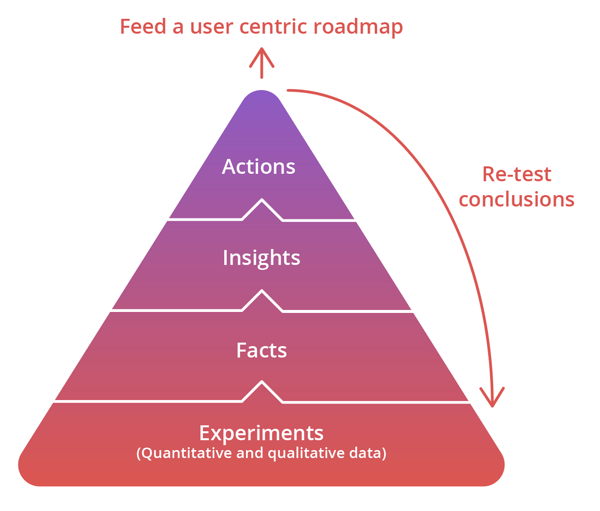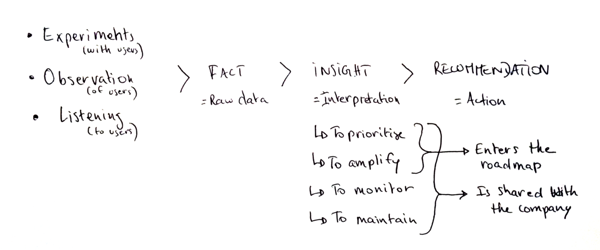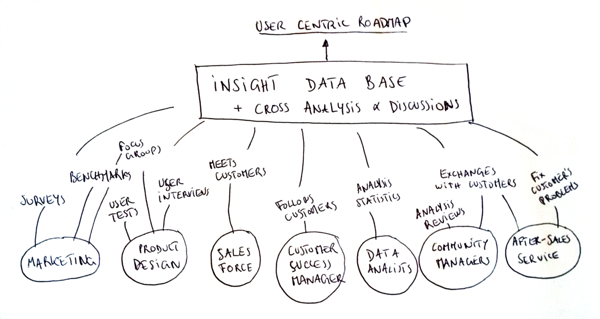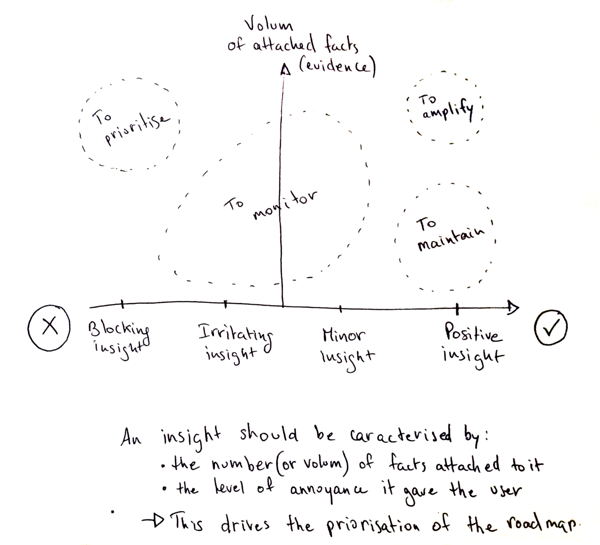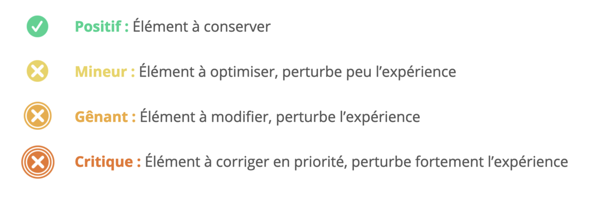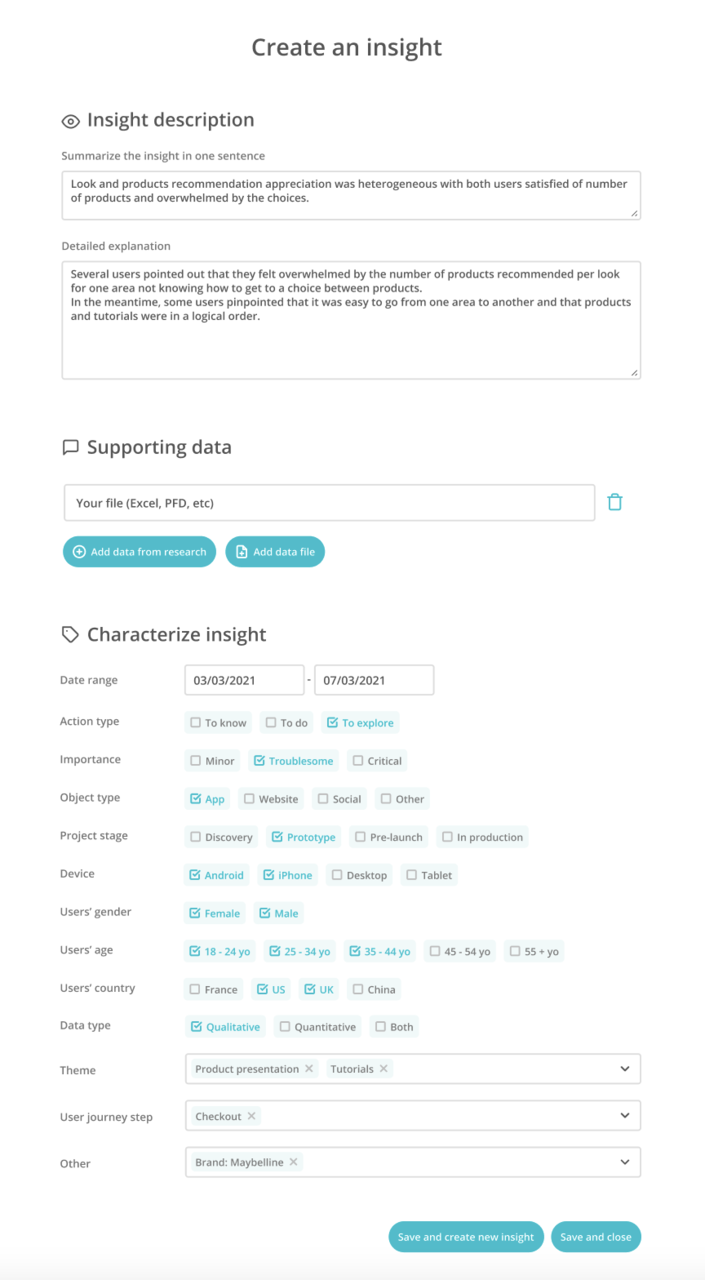August 24, 2021
Atomic Research | Decoding a User-centric Method
Don't know how to make the mostof your user testing results, or are you getting tired of data accumulating in Cloud space? Do you want to become more efficient and fine-tune your customer knowledge to prioritize your projects? In this case, atomic research is for you! Small and medium-sized businesses, large groups, all companies are concerned by the emergence of this method that breaks down the UX to get only the best out of it. This approach may seem new to some, but Ferpection has been using it for years. You could even say that we have made it one of our main pillars. But what is it? How does it work, what are its challenges, advantages and difficulties of implementation? You will know everything after reading this article.
Atomic research, what it is?
Definition
Atomic research is a new method for organizing and classifying data collected from listening and observing users. Whether qualitative or quantitative, this knowledge from UX research (User eXperience Research) is broken down to an “atomic” level, and can then be analyzed. From their conclusions, the actions to prioritize are identified.
This technique is divided into 4 steps:
- Experience : “We did this ”;
- Observation of facts: “and we founf out this ”;
- Insights: “which makes us think this ”;
- Recommendations: “so we’ll do that ”.
Context: Origin of atomic research
Daniel Pidcock is the one behind this innovative approach. He was inspired by atomic design to optimize the organization of data resulting from user research testing. This new processing technique was born from a painful, urgent and recognized observation. It became crucial to:
- consolidate studies that are usually conducted independently to analyze them as a whole
- break them down in a precise and factual manner
- standardize the flow of information
- make them accessible to everyone
- prioritize the actions to be implemented
It was also obvious that most of the UX research testing results from traditional methods were used to optimize a product, but did not contribute to building an effective, user-centric strategy. Best case scenario, they were stored in a common drive that had been left abandoned. Worst case scenario, they were lying around in 150-page PDF files. These studies are only useful in very specific cases, associated with a particular context. As a result, these conclusions were irrevocably lost. Based on this observation, it became clear that a new UX analytics technique was needed.
Operation
The separation of the data allows for multi-level analysis and processing.
For example, a designer and a marketing manager conducting a similar UX research experiment will not come up with the same observations. However, they will still be able to cross-reference their results to highlight a trend that was previously invisible.
The vision that emerges is both more global and more precise, the result of continuous user feedback. Research is no longer ad hoc, and customer knowledge becomes more precise.
Atomic research: a strategic digital tool for ambitious objectives
Aggregate the results of the UX research
One of the common challenges for any company that implements user testing, quantitative surveys, and other marketing metrics is the data fragmentation that results from them. Different hosts, different files and software, sometimes random storage, the lack of standardization is a real problem. In fact, for any new employee or outside provider, determining whether an experiment has already been conducted and analyzing its results is impossible.
This is precisely one of the great promises of atomic research : consolidating all studies in a common database. This data source is searchable, shareable and accessible, accurate, industrialized and flexible. Thus, the conclusions of an online survey launched by the mobile application design team would be visible and analyzable by all other design, marketing, sales, data analysis departments, etc.
A use allowing a better quantitative analysis of the user testing, to cross the sum of the information obtained, and to prioritize the actions to be taken. Information would no longer be consigned to ghost files. It would finally be used and placed at the disposal of a problem-solving and project advancement dynamic.
One of the strengths of Atomic Research's strategy is its ability to centralize the data collected by each hub and to draw out the lessons learned for the benefit of all.
Place the facts and the user at the core of the process
In practice, everything starts from the facts. Because it is impossible to determine a relevant action without it being supported by concrete results from experiment. With this approach, there is no more room for guesswork: the choice is made according to the evidence provided. Likewise, the more sources (experiments) there are, the clearer, more justifiable and understandable the reasoning behind them.
Develop a customized UX strategy
Thanks to this standardized work methodology, based on verified and verifiable facts, it becomes much easier to share the knowledge and learning acquired. All that remains to be done is to collect the results of the various services and to implement targeted actions: these are the recommendations. These recommendations allow us to establish a user-centric roadmap. The blockages are highlighted, and the drivers to prevent failure are activated. Thus, UX strategies are developed with more confidence. In fact, each action is prioritized according to the intensity of the user blockage and the number of users concerned, in order to bring the most value to the greatest number.
Break down the UX and sustainably optimize intra-company communication: the benefits
What are the concrete benefits of atomic research for companies?
Improvement of global performance
UX data is collected, identifiable and quickly searchable. Where previously several files in different media would have had to be studied, finding insights and conclusions is just a few clicks away. Filters provide quick access to documents.
Information collected is kept over time
It is common that some learnings are not immediately usable. Thanks to tags, this information will no longer be lost and will be able to feed and improve future roadmaps and projects. Regardless of the status of the UX information collected, it will be stored in an insight, tagged and available for consultation as soon as the need arises. In addition, it will be possible in the future to retrace the route of the thought chain. By going back from the recommendation through the insight to the collected facts, it will be possible to understand why a decision was taken.
Data can be shared endlessly
Whether it's online surveys, focus groups, in-store actions, store reviews, social media comments, after-sales service feedback, etc. Access to all staff, which will, among other things, avoid duplicate studies. It is not uncommon for two employees from different departments (e.g. marketing and design) to launch the exact same campaign. With this approach, it will be possible to see in advance if testing has already been undertaken. A database that is useful for everyone, and that will allow new employees as well as external service providers to be up to date on the steps taken. It will also offer the possibility to consolidate and cross-reference all user feedback. The result will be a more global and realistic vision of the problems they may encounter throughout their experience.
With this in mind, atomic research saves time and optimizes the management of technological, budgetary and human resources. A powerful tool when it comes to facilitating communication between different departments of a company.
Rethinking the deep organization of companies: the challenges
Like any innovative process, atomic research within a company requires facing some challenges. But which ones?
Thinking that it is primarily a technical tool
Many managers ask us what tools are needed to implement it. But the real challenge lies more in the internal organization of the company rather than in raw technology. It is primarily human participation that guarantees the success of the approach. For actions to be decided, data must be collected, added to the database, insights created, analyzed and categorized, and conclusions drawn.
Finally, the principle of atomic research is to have an idea linked to another idea, linked to another idea, so any tool that allows to create a database could work.
Convincing companies
It is also necessary to convince companies trapped in their habits of the merits of this method. To be effective, it requires updating the internal organization of a structure and standardizing the media and software used. This is a long-term process, which may seem difficult at first, but which will guarantee a permanent consistency of the system. Airtable, Dovetail or Notion can be good supports to do atomic research, but they will be used above all to centralize the results of a team work.
Team work
Once the company is convinced, the teams must work together. To do so, it is essential to change their communication and organization methods. Because, if they don't play the game, maintaining the long-term sustainability of the tool will be difficult. In fact, especially in large groups, each department has its own silo and its own way of communicating. A sometimes independent operation that contributes to the fragmentation of data. Therefore, it is crucial to make them understand the importance of standardizing relational systems and industrializing the functioning of insights so that they are clear to all. After all, creating insights and grouping them together is essential to link the information together and plan the projects to be prioritized.
For effective monitoring of atomic research, we recommend conducting analyses every two weeks, and sharing them every 4 months with all departments. This is done in order to draw global conclusions and to regularly review the improvements to be launched.
Atomic research allows a real improvement of UX and marketing while placing the user at the core of a strategy to improve his daily life. Like anything that lasts a long time, it requires rigor, organization and precision. At Ferpection, we put our expertise and support at your fingertips to facilitate your efforts. If you have any questions, contact us for a chat!
If you liked this article and you want to learn more about UX research in general, do not hesitate to consult our video on this topic !
Sources:
All articles from the category: User research | RSS
